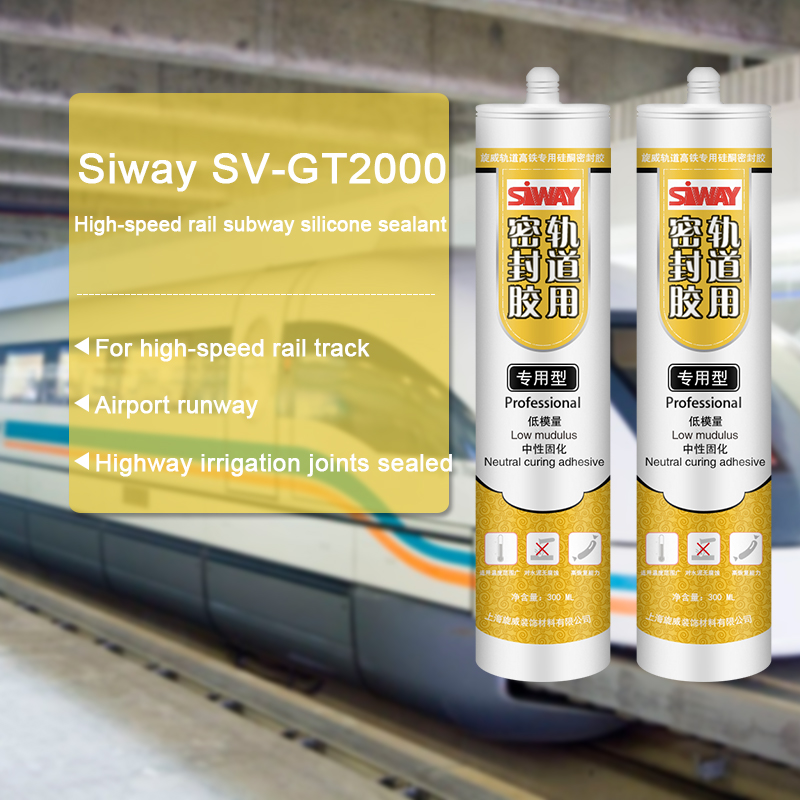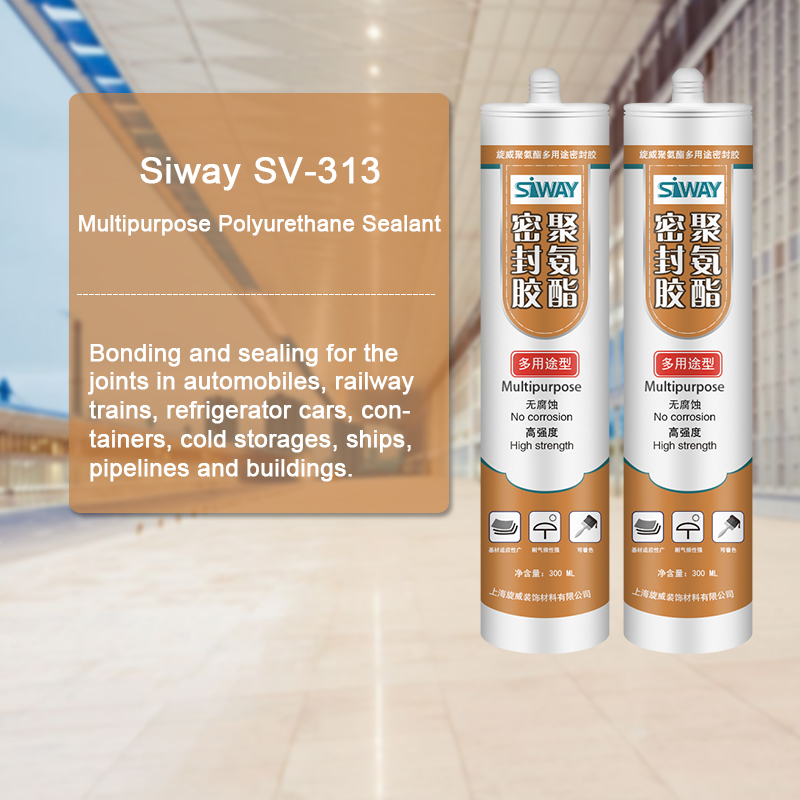15 Years Manufacturer SV-GT2000 High-speed rail subway silicone sealant for Greece Factory
Short Description:
Description SV-GT2000 High-speed rail subway silicone sealant is a one-component, low modulus, neutral curing adhesive. For most of the stone, ceramic and cement components, can produce excellent adhesion Key Features (1) easy to use: can be used at any time out; (2) excellent thixotropy and extrusion, at any temperature (-40 ℃ to 100 ℃) can be extruded; (3) good adhesion, the stone, ceramics and cement components and other building materials with excellent adhesion properties; no poll...
We offer great strength in quality and development,merchandising,sales and marketing and operation for 15 Years Manufacturer SV-GT2000 High-speed rail subway silicone sealant for Greece Factory, items won certifications with the regional and international primary authorities. For far more detailed information, please contact us!
Description
SV-GT2000 High-speed rail subway silicone sealant is a one-component, low modulus, neutral curing adhesive. For most of the stone, ceramic and cement components, can produce excellent adhesion
Key Features
(1) easy to use: can be used at any time out;
(2) excellent thixotropy and extrusion, at any temperature (-40 ℃ to 100 ℃) can be extruded;
(3) good adhesion, the stone, ceramics and cement components and other building materials with excellent adhesion properties; no pollution of the porous material;
(4) excellent weather resistance, aging performance, excellent tensile and compression resilience, can carry ± 30% displacement capacity;
(5) neutral curing, stone, cement and other building materials without corrosive, to overcome the shortcomings of acid corrosion material.
(6) base modulus: passive deformation occurs when the role of moderate stress on the concrete substrate to ensure that the concrete surface is not destroyed;
(7) high elasticity high recovery capacity: can be repeated from the seams with the movement, fast response fast response, permanent deformation of small.
Basic Application
1.For high-speed rail track, airport runway, highway irrigation joints sealed, can withstand large displacement;
2.Can also be used for other concrete pavement sealing, subway engineering, tunnels, bridges and other projects sealed.
Technical data sheet
|
Test project |
Unit | value | ||
| surface drying time(25℃,50%R.H.) | min | ≤60 | ||
| Sagging(70℃) | vertical | mm | ≤3 | |
| Horizontal | mm | 0 | ||
| Mass loss rate | / | ≤5% | ||
| Elastic recovery rate | / | ≥80% | ||
| 100% tensile strength | 23℃ | MPa | ≤0.3 | |
| -20℃ | MPa | ≤0.3 | ||
| tensile strength | 23℃ | MPa | ≥1.0 | |
| -20℃ | MPa | ≤2.0 | ||
| 168 h after thermal aging (80 ℃) | MPa | ≥0.8 | ||
| 168 h after alkali treatment | MPa | ≥0.8 | ||
| Breaking elongation | 23℃ | / | ≥800% | |
| -20℃ | / | ≥600% | ||
| 168 h after thermal aging (80 ℃) | / | ≥600% | ||
| 168 h after alkali treatment | / | ≥600% | ||
| Bond strength | 23℃ | / | No damaging | |
| -20℃ | / | No damaging | ||
| 168 h after thermal aging (80 ℃) | / | No damaging | ||
| 96 h after immersion | / | No damaging | ||
Color
Black, White, Gray
Package
300ml in cartridge * 24 per box, 590ml in sausage *20 per box
Shelf life
12 months
Note
If you want the TDS or MSDS or other details, please contact with our sales person.
Check out our blog for clickable links to the items below!
Blog- https://www.heywandererblog.com/2017/06/diy-stock-tank-pool-everything-you-need.html
Instagram- www.instagram.com/heywanderer
E-mail- heywanderer@gmail.com
Things you will need:
- Stock tank (size of your choosing- ours is 8 ft.)
- Above Ground Pool Pump
- Weatherproof Silicone Sealant
- Hole Saw with Arbor
- Plunger Valves
- Pool Outlet
- 1-3 Rubber Washers (or Gaskets)
- 1 Strainer Nut
Other things you will need for maintenance:
- Chlorine Tablets
- Floating Pool Dispenser
- Water Testing Kit
Step 1- Find a nice level area to lay the stock tank on. If the area where you have chosen isn’t level, use sand or rocks to build up whatever side needs it. It is very important that your stock tank be level so there aren’t any unexpected leaks.
Step 2- Cut holes in your stock tank. I’m not going to lie- this is a pain in the butt. We bought a hole saw with an arbor and it took two people to get through the metal. You will need two holes, one at the top and one at the bottom. In an above ground pool, these aren’t usually right on top of each other, but ours are. We haven’t ever seen this as a problem.
Step 3- Start assembling the parts. In the pool pump package there is a packet with instructions, warnings and troubleshooting. This packet proved to be vital in the setup of the pool. I did end up getting 2 gaskets for the bottom section (the drain section), one for the inside of the pool and one for the outside. It only says you need one for the inside, but this was causing a drip for us. I also put thread seal tape around the connections that were closest to the pool. There are a lot of connections, and each one has a gasket, so you could probably get away without the tape. I didn’t put it on all the connections, the only ones that really seemed to matter were the ones that are connecting the hoses to the pool.
Step 4- Apply silicone waterproof sealant around all crevices involving the input and output parts. I did this on the inside of the pool and the outside. And I applied it VERY HEAVILY and did two layers, allowing one to dry before the second was applied. Sealing these crevices is one of the most important parts. This is what is going to keep the water in the pool. Well all of these steps are leading up to keeping water in the pool, but if there is any chance that it’s going to be getting out, this is what will save you.
Step 5- Test for leaks. Before I added water to the pool, I took a water bottle and poured a good amount of water on the input and output parts. You could also just use a water hose. I would make sure the hose wasn’t on full blast. You don’t want to accidentally penetrate the sealant.
Step 6- Once you are sure there aren’t any leaks, fill the pool just above the bottom hole/output. Check again to see if any leaks have started. If there aren’t any, fill the rest of the pool up!
Step 7- Turn the pump on. Make sure both plunger valves are open/unlocked. When you first do this water may not come out of the output, but there is a solution! Twist off the knob on top of the filter pump to let some air out. Some water may escape too and that’s okay, just be ready to screw it back on as soon as the water starts coming out.
Subscribe with a click here – https://goo.gl/5Z2CJ7
Cases, which are designed to attach to, support, or otherwise hold a mobile phone, are popular accessories for many phones, particularly mainstream smartphones. Case measures are based on the display inches (e.g. 5 inch display). There are different types:
Pouches and sleeves
Holsters
Shells
Skins
Safety Straps
Bumpers
Flip cases and wallets
Screen protection and body films
Drop and shock protection
Leather Case
Holsters are commonly used alone for devices that include rubberized padding, and/or are made of plastic and without exposed rigid corners. Heavy duty cases are designed to protect from drops and scratches.
A Standing case improves user experience, being specially recommended for multimedia, videos and audio. Folio case is a combination case and stand, and may include a keyboard (USB for OTG smartphones or bluetooth keyboard).
Skins and design covers can serve for protection and personalization. These are the result of the relatively “naked” designs produced by manufacturers such as Apple, where the metal and glass components of the device are exposed and vulnerable to damage. They are distinct from holsters, in allowing use of the device while in the case, but in many instances include a belt clip or other device giving it the functionality of a holster. They are made of hard plastic, rubber, or in the newer market adhesive-backed vinyl pieces. Vinyl skins can be ordered on many websites and come pre-cut to fit your cell phone or another electronic device. Vinyl material may be calendared or cast, with the latter being more expensive. Calendered vinyl is expected to only be used for short-mid duration (10 years) while cast vinyl is used on a more long term basis. Calendered vinyl also tends to shrink in the heat and can be shaped into any form (above 80 degrees Celsius) but might fade in direct sunlight.The today’s standard of calendered films is almost as good as the cast vinyl. Cast vinyl avoids most problems, but costs up to 250% more. 3M has manufactured a cast vinyl product that they call “Controltac”. This vinyl cover maintains a more glossy look and provides an air release channel that prevents bubbles during placement. The more popular is the cast vinyl because of the range of designs.
Customized phone cases use custom printing. Different companies have different methods of printing on cases, some utilize sublimation for printing on mobile phone cases, other methods include inkjet printed skins and Dye-Sublimation 3D printing methods.
Some phones have a replaceable cover. A release button on the cover lets it pop off to be replaced with the new cell cover. Phones that lack a replaceable cover can accept a slip on or snap on cover. These come in leather, vinyl, silicone, or hard plastic.
Functional cases can integrate an external battery, a USB, Bluetooth, WiFi keyboard and touchpad mouse in a similar way to tablets.
It’s totally FREE to subscribe to ASMR.Show on YouTube!
Did I remind you, don’t forget to subscribe ![]()





